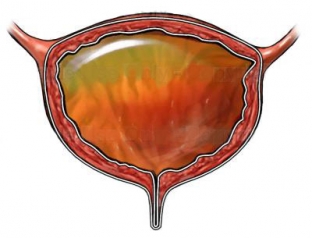The act of urination is one of the physiological processes of the body, through which a person satisfies his natural needs. Any disorders and changes in the act of urination are called dysuria and signal the presence of a pathological process in the urinary system of the body. Most dysuric manifestations are characterized by such changes in which urine is excreted too often, in large quantities or uncontrollably. At the same time, such urination disorder as urinary retention is one of the most dangerous manifestations of dysuria, the occurrence of which indicates the presence of a rather serious disease of the urinary system.
Classification and clinical manifestations of urinary retention
Urine retention – This is a pathological condition in which during the act of urination it is not possible to completely empty the bladder. Urinary retention occurs against the background of pathological processes in the bladder, urethra and prostate gland, or against the background of damage to the nervous system of the body. Urinary retention can be acute and chronic, as well as complete and partial. Acute urinary retention is always only complete and is a life-threatening condition that requires emergency medical care. Among urological pathology, urinary retention is often caused by obstructive processes that occur at different levels of the urinary tract.
Urinary retention:
- why does acute urinary retention occur and how does it manifest itself;
- chronic urinary retention: clinical manifestations;
- partial and complete chronic urinary retention.
Why acute urinary retention occurs
Acute urinary retention is a dangerous condition that occurs spontaneously and is characterized by a complete cessation of urination in the presence of a painful urge to urinate. Acute urinary retention occurs in the following cases:
- if there is a mechanical obstruction to the outflow of urine, for example, with prostatic hyperplasia, bladder stones, etc.;
- reflex acute urinary retention after surgery with a long postoperative bed period, after anesthesia, etc.;
- with a spontaneous exacerbation of the disease, which previously led to the development of partial chronic urinary retention;
- with traumatic lesions of the urethra, trauma of the prostate gland, obstruction of the urethra by a stone or a foreign body;
- for lesions of the spinal cord.
In all these conditions, the bladder is full, resulting in a sharp pain in the lower abdomen. Patients with acute urinary retention require emergency medical care, the nature of which depends on the cause of the pathological process.
Chronic urinary retention: clinical manifestations
 All types of difficult urination lead to the development of chronic urinary retention. At the same time, under conditions of increased resistance of the urethra, hypertrophy of the muscular wall of the bladder develops, which determines the degree of compensation and excretion of urine. With difficulty urinating due to any obstruction of the outflow of urine in the neck of the bladder or urethra, as well as a decrease in the tone of the muscles that push urine out, the bladder is not completely emptied, part of the urine remains in it. This is how chronic urinary retention is formed. Clinically, chronic urinary retention is manifested by a feeling of incomplete emptying of the bladder, incompleteness of the act of urination, a feeling of dissatisfaction after urination, as well as the absence of an active final contraction of the bladder and urethra,
All types of difficult urination lead to the development of chronic urinary retention. At the same time, under conditions of increased resistance of the urethra, hypertrophy of the muscular wall of the bladder develops, which determines the degree of compensation and excretion of urine. With difficulty urinating due to any obstruction of the outflow of urine in the neck of the bladder or urethra, as well as a decrease in the tone of the muscles that push urine out, the bladder is not completely emptied, part of the urine remains in it. This is how chronic urinary retention is formed. Clinically, chronic urinary retention is manifested by a feeling of incomplete emptying of the bladder, incompleteness of the act of urination, a feeling of dissatisfaction after urination, as well as the absence of an active final contraction of the bladder and urethra,









Add a comment